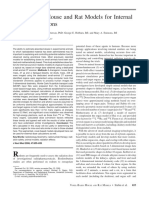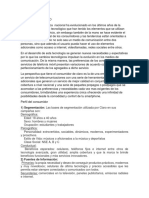Computer Physics Communications 176 (2007) 33–37
www.elsevier.com/locate/cpc
Input files with ORNL—mathematical phantoms
of the human body for MCNP-4B ✩
D. Krstić, D. Nikezić ∗
University of Kragujevac, Faculty of Science, R. Domanovic 12, 34000 Kragujevac, Serbia
Received 12 January 2006; received in revised form 15 May 2006; accepted 6 June 2006
Available online 15 September 2006
Abstract
Protection against ionizing radiation requires information on the absorbed doses in organs of the human body. Implantation of many dosimeters
in the human body is undesirable (or impossible), so the doses in organs are not measurable and some kind of dose calculation has to be applied.
Calculation of doses in organs requests: (a) an exact description of the geometry of organs, (b) the chemical constitution of tissues, and (c) ap-
propriate computer programs. The first two items, (a) and (b), make a so-called “phantom”. In another words, the “phantom of a human body”
is a mathematical representation of the human body including all other relevant information. All organs are represented with geometrical bodies
(like cylinders, ellipsoids, tori, cones etc.), which are described with suitable mathematical equations. A corresponding chemical constitution for
various types of organ tissues is also defined.
MCNP-4B (Monte Carlo N-Particle) is often used as transport code. Users of this software prepare an “input file” providing all necessary
information for program execution. This information includes: (a) source definition—type of ionizing radiation, energy spectrum, and geometry
of the source; (b) target definition—material constitution, geometry, location in respect to the source etc.; (c) characterization of absorbing media
between the source and target; (d) output tally, etc.
This paper presents input files with “human phantoms” for the MCNP-4B code. The input files with “phantoms” were prepared based on
publications issued by the Oak Ridge National Laboratory (ORNL). Seven input files relating to different age groups (newborn, 1, 5, 10, 15 years,
as well as, male and female adults) are presented here. A test example and comparison with other data found in literature are also given.
Program summary
Title of program: INPUT FILES, AMALE, AFEMALE, AGE15, AGE10, AGE5, AGE01, NEWB
Catalogue identifier: ADYF_v1_0
Program summary URL: http://cpc.cs.qub.ac.uk/summaries/ADYF_v1_0
Program obtainable from: CPC Program Library, Queen’s University of Belfast, N. Ireland
Computer: PC Pentium 3+
Operating systems: Windows 98
Programming language used: Fortran
Memory required to execute with typical data: 128 MB
No. of lines in distributed program, including test data, etc.: 2879
No. of bytes in distributed program, including test data, etc.: 23 151
Distribution format: tar.gz
External subprograms used: The entire code must be linked with the MCNP-4B
Nature of problem: The human body and all organs are represented with equations of 3D geometrical bodies. All equations and other relevant
data (material composition, densities, etc.) were programmed as input files for MCNP-4B
© 2006 Elsevier B.V. All rights reserved.
✩
This paper and its associated computer program are available via the Computer Physics Communications homepage on ScienceDirect (http://www.sciencedirect.
com/science/journal/00104655).
* Corresponding author.
E-mail address: nikezic@kg.ac.yu (D. Nikezić).
0010-4655/$ – see front matter © 2006 Elsevier B.V. All rights reserved.
doi:10.1016/j.cpc.2006.06.016
�34 D. Krstić, D. Nikezić / Computer Physics Communications 176 (2007) 33–37
PACS: 02.50.Ng; 07.05.Tp; 87.53.Dq; 87.53.Wz
Keywords: MCNP-4B code; Input file; Mathematical phantom; Age dependent
1. Introduction tron Monte Carlo transport code. The user creates an input file
that is subsequently read by MCNP. This file contains informa-
The effective dose, E, is one of the main quantities in ra- tion about the problem such as: (i) the geometry specification,
diation protection against ionizing radiation. Dose levels and (ii) the description of materials and selection of cross-section
regulatory limits for the public and professionals are related just evaluations, (iii) the location and characteristics of the source,
to this quantity. The effective dose was defined in recommenda- (iv) the type of answers or tallies desired, and (v) any variance
tions issued by the International Commission on Radiological reduction techniques used to improve efficiency. The MCNP
Protection (ICRP), as treats an arbitrary three-dimensional geometry of user-defined
� material cells bounded by first and second-degree surfaces and
E= wT HT , (1)
fourth-degree elliptical tori. The cells are defined by the inter-
T
sections, unions, and complements of the regions bounded by
where HT is the equivalent dose in an organ T , and wT is the the surfaces. Surfaces are defined by supplying coefficients to
tissue weighting factor for that organ [1,2]. Summation has to the analytic surface equations or, for certain types of surfaces,
be done across all organs of the human body. The Commission known points on the surfaces. The MCNP performs extensive
distinguished “main” organs and the “remainder”. On the other internal checking to find input errors in the geometry. The tally
hand, the equivalent dose of organ T , was defined as cards are used to specify what type of information the user
�
HT = wR DT ,R , (2) wants to obtain from the Monte Carlo calculation. That could
R be, for example, a current of particles across a surface, flux of
where, DT ,R is the mean absorbed dose (the energy absorbed particles at the point, energy deposited averaged over a cell,
per unit mass) in an organ by the radiation type R, and wR is the etc. All MCNP tallies are normalized per starting particle his-
radiation weighting factor for the radiation type R; here sum- tory and are printed in output with an estimated relative error of
mation has to be performed across different types of ionizing the tally corresponding to one standard deviation.
radiation (neutron, alphas, photons, etc.). In this paper, analytical phantoms of the human body, based
To know the effective dose, it was necessary to determine on ORNL publications [17] were used to create input files
the absorbed (and equivalent) doses in all organs of the hu- for MCNP-4B transport code. Similar software, called “Body
man body. In such a way, the effective dose is not a measurable Builder” is commercially available [18].
quantity, and some kind of calculation of absorbed doses in or-
gans has to be done for given irradiation conditions. To perform 3. Description of phantoms and input files
this task, a model of the human body, known as a “phantom” is
needed [3–5]. Analytical models of the human body were described in
Until now, two kinds of human phantoms were in use. The Oak Ridge National Laboratory (ORNL) publications [17]. All
first type was a family of analytical phantoms, where all organs organs of the human body were represented with analytical
and the whole human body were represented with 3D analyt- equations of various three-dimensional geometrical bodies. In-
ical equations [6–10]. The chemical constitution of different equalities were also used to represent some organs. It is out
tissues presented in the human body was also given. The second of the scope of this work to give all equations and inequalities
type was, so-called, “voxel (volume-pixel)” phantom, where the used for organs of human phantoms and only the most impor-
human body was represented with many small elements with tant characteristics are given here.
defined borders, dimensions and chemical constitution. Voxel The ORNL phantom consisted of three sections: (1) the
phantoms were obtained from digital images recorded from trunk and arms were represented as elliptical cylinders; (2) legs
scanning of real persons by computed tomography or magnetic and feet were two truncated circular cones; and (3) the neck
resonance imaging (MRI) and they are representations of a real and head were represented with a circular cylinder on which
human body [11–13]. Both kinds of phantoms are virtual hu- another elliptical cylinder, covered by half of an ellipsoid was
mans for which the absorbed dose in organs and tissues from situated. Two ellipsoids representing the female breasts were at-
exposure to ionizing radiation can be calculated using transport tached to the trunk (of the female phantom). In addition to the
codes such as MCNP [14], EGS4 (Electron Gamma Shower geometrical shapes, the chemical constitution and densities of
Version 4) [15], PENELOPE (PENetration and Energy LOss tissues of particular organs were needed for absorbed dose cal-
of Positrons and Electron) [16], etc. culations. Three types of tissues, skeletal, lung and soft, with
different densities and elemental compositions were present in
2. MCNP-4B code ORNL phantoms.
In this kind of geometric problem a suitable choice of co-
MCNP is a general-purpose, continuous energy, generalized ordinate system was very important and can significantly re-
—geometry, time-dependent, coupled neutron, photon or elec- duce the calculation time in some problems. The coordinate
� D. Krstić, D. Nikezić / Computer Physics Communications 176 (2007) 33–37 35
Fig. 1. Longitude crosses of ORNL phantom.
Fig. 2. Transversal cross sections of an adult male and of female phantoms.
origin was taken at the center of the lower base of the trunk puter screen and represented the cross section of the phantom
section of the phantom. The z-axis was directed vertically up- with the plane defined by the user. As an illustration, in Fig. 1,
ward. The y-axis and x-axis were horizontally directed to the the cross sections with the vertical plane (with equation Y = 0)
posterior side and towards the left-hand side of the phantom, are shown for all phantoms. Various organs could be seen in
respectively. External shapes of organs were defined as planes, these figures. Some organs denoted in the adult male phantom
spheres, cylinders, cones, ellipsoids, elliptical cylinders, tori are as follows: (1) lung; (2) liver; (3) heart; (4) spleen; (5) brain;
and combinations of these geometrical bodies. (6) colon; (7) leg bones; (8) arm bones; (9) pelvis; (10) upper
All equations and inequalities for organs of all phantoms, part of the spine; (11) ribs.
with other relevant information (elemental compositions, vol- In Fig. 2, lateral cross-sections of adult male and adult fe-
umes, masses, etc.), were programmed in input files for MCNP- male phantoms with horizontal planes (Z = 55 cm for male)
4B code. By combining surfaces through Bull algebra, MCNP- and (Z = 46.87 cm for female) are shown. The organs seen in
4B forms cells representing various organs. So far, 46 cells and the male phantom (left panel) are: (1) lungs; (2) spine; (3) arm
175 surfaces were used for a male phantom in the input file. The bones; (4) heart, and (5) ribs. In female phantoms one could see
female phantom was more complicated (due to the breasts). In the same organs, plus (6) breasts attached to the trunk.
total, seven different input files were created: adult male, adult
female, 15 years old, 10 years old, 5 year old child, 1 year old 4. Numerical example
baby and newborn. All these phantoms were hermaphroditic,
except the adult male and adult female. The 15 year old phan- Numerical calculations were performed for all phantoms in
tom represented both a 15 year old male and an adult female order to check whether they could be used as input to MCNP-
with portions of ellipsoids attached to the trunk representing fe- 4B. Point like radioactive sources, 137 Cs, with an energy of
male breasts. 661.6 keV were situated in front of the face of each phantom
at the distance of 1 m. In this way sources were at different
Graphical output from MCNP-4B heights (corresponding to the height of the phantom face). The
absorbed doses per one emitted photon were calculated in all
MCNP-4B enabled graphical representation of the geometry organs of human phantoms and the results are given in Figs. 3
defined in the input file. The output was obtained on the com- and 4. The energy deposited tally (F6 in MCNP terminology)
�36 D. Krstić, D. Nikezić / Computer Physics Communications 176 (2007) 33–37
Fig. 3. Absorbed dose per one photon for some organs for phantoms of the human body.
Fig. 4. Absorbed dose per one photon for some organs for phantoms of the human body.
was used to calculate the absorbed doses presented here. The male phantom assuming the AP geometry described in [2]. The
number of histories was 107 per one calculation. This number same reference gives the conversion factors for various organs,
ensured that the relative standard deviation (RSD) calculated by relating the absorbed dose in organs per unit air kerma free-
MCNP was smaller than 5% for all organs. The RSD was larger in-air (Gy per Gy). The conversion factors as a function of
for smaller organs because the number of “hits” was smaller; it photon energy in the range between 0.1 and 10 MeV, were cal-
was the largest for adrenals (4.6%), thymus (4%) and thyroid culated here for liver, lung and testes and compared with ICRP
(3%) for the adult male phantom. 74 [2] in Table 1. The doses were calculated in the same irra-
Doses in organs were variable with phantoms and the varia- diation conditions, parallel photon beam incident on the front
tions were up to the factor of 3. Some doses decreased regularly of the phantom (AP geometry). The discrepancy was larger in
with age (lung, pelvis, skin, spine, etc.) while doses in other the lower energy region, below 1 MeV, where it achieved up
organs changed irregularly with age. On the other hand, some to 10%. If the energy is larger than 1 MeV the difference is
doses remained almost constant (ribs, thymus, skull, etc.) and much smaller and in some cases it is less than 5%. In addition,
some doses were changed only slightly. the discrepancy between two groups of data was different for
various organs. The discrepancies were probably caused by the
4.1. Comparison with ICRP 74 report different phantoms used. Secondary particles were treated in a
different way in the low energy region and this can cause some
In order to check the validity of the input files with the phan- little difference too. The MIRD phantom was used in ICRP
toms created here, calculations were performed for the adult 74 [2], which is different in comparison to the ORNL phan-
� D. Krstić, D. Nikezić / Computer Physics Communications 176 (2007) 33–37 37
Table 1
Conversion coefficients—absorbed dose per unit air kerma free-in-air (in Gy/Gy) for liver, lung and testes, calculated with MCNP-4B and input files described in
this work, and given in ICRP 74 [2] for energies between 0.1 up to 10 MeV
Energy Liver Lung Testes
(MeV) This work ICRP 74 This work ICRP 74 This work ICRP 74
0.10 1.378 1.403 1.379 1.291 1.801 1.855
0.15 1.183 1.261 1.196 1.164 1.511 1.631
0.20 1.092 1.176 1.106 1.101 1.366 1.497
0.30 1.010 1.094 1.045 1.044 1.241 1.366
0.40 0.975 1.056 1.016 1.021 1.181 1.303
0.50 0.953 1.034 0.998 1.009 1.144 1.265
0.60 0.938 1.022 0.984 1.003 1.115 1.238
0.70 0.924 1.008 0.971 0.997 1.082 1.202
1.0 0.919 1.002 0.965 0.995 1.063 1.177
2.0 0.918 1.002 0.958 0.991 1.018 1.119
4.0 0.928 1.006 0.960 0.985 1.009 1.071
6.0 0.935 1.003 0.966 0.980 1.012 1.043
8.0 0.940 0.998 0.970 0.975 1.013 1.023
10.0 0.942 0.994 0.974 0.971 1.016 1.004
tom used in the present work. The difference between the two Values, Annals of ICRP23, ICRP Publication, vol. 89, Pergamon Press,
phantoms is not only in geometry, but tissue densities are also Oxford, 2002.
[5] International Commission on Radiation Units and Measurements, ICRU
different.
REPORT 48, Phantoms and Computational Models in Therapy, Diagnos-
tics and Protection, 1992.
5. Conclusion [6] W.S. Snyder, Estimation of absorbed fraction of energy from photon
sources in body organs, in: I. Miric (Ed.), Proceedings of the International
In this work input files for MCNP-4B with seven phan- Summer School on Radiation Protection, in: Radiation Dosimetry, vol. 1,
toms of the human body according to ICRP recommendations Cavtat, Yugoslavia, 1970, pp. 108–135.
Nos 60, 74, 23 and 89 [1–4] were prepared. A numerical test [7] M. Zankl, N. Petoussi, G. Drexler, Effective dose and effective dose
equivalent—the impact of the new ICRP definition for external photon
example was also given. The input files presented here could be
irradiation, Health Phys. 62 (1992) 395–399.
used further, but the users should define their own geometrical [8] Y. Yamaguchi, Age-dependent effective dose for external photons, Radiat.
model with source and tally cards, and other relevant parame- Prot. Dosim. 55 (1994) 123–129.
ters, according to the problem being considered. Conversion [9] D.P. Chou, J.N. Wang, I.J. Chen, B.J. Chang, Age-dependent protection
factors, calculated with the phantoms presented here were com- quantities for external neutron irradiation, Radiat. Prot. Dosim. 104 (2003)
5–16.
pared with those given in ICRP 74 report [2] and relatively good
[10] J.H. Kim, J.H. Whang, C.S. Kim, Paired-organ and other selected ab-
agreement was found. sorbed fraction for the Korean reference adult male model, Radiat. Prot.
Dosim., doi:10.1093/rpd/nci359.
Acknowledgement [11] X.G. Xu, T.C. Chao, A. Bozkurt, VIP-MAN: an image based whole-body
adult male model constructed from color photographs of the Visible Hu-
The authors thank the Serbian Ministry of Science and Envi- man Project for multi-particle Monte Carlo calculations, Health Phys. 78
ronment Protection, which supported this work through project (2000) 476–485.
[12] R. Kramer, J.W. Vieira, H.J. Khoury, F.R.A. Lima, D. Fnelle, All about
141023.
MAX: a male adult voxel phantom for Monte Carlo calculations in radia-
tion protection dosimetry, Phys. Med. Biol. 48 (2003) 1239–1262.
References [13] M. Caon, Voxel-based computational models of real human anatomy: a re-
view, Radiat. Environ. Biophys. 42 (2004) 229–235.
[1] International Commission on Radiological Protection, Recommendations [14] J.F. Briesmeister (Ed.), MCNP—A General Monte Carlo N -Particle
of the International Commission on Radiological Protection, ICRP Publi- Transport Code, Version 4B, LA-12625-M, Los Alamos National Labo-
cation, vol. 60, Pergamon Press, Oxford, 1991. ratory, Los Alamos, New Mexico, 1997.
[2] International Commission on Radiological Protection, Conversion Coef- [15] EGS4 code, available at: http://www.slac.stanford.edu/egs/.
ficients for Use in Radiological Protection Against External Radiation, [16] F. Salvat, J.M. Fernandez-Varea, E. Acosta, J. Sempau, PENELOPE—
ICRP Publication, vol. 74, Pergamon Press, Oxford, 1996. A Code System for Monte Carlo Simulation of Electron and Photon Trans-
[3] International Commission on Radiological Protection, Reference Man: port, Nuclear Energy Agency OECD/NEA, Issy-les-Moulineaux, France,
Anatomical, Physiological and Metabolic Characteristics, ICRP Publica- 2001, available on the web at http://www.nea.fr.
tion, vol. 23, Pergamon Press, Oxford, 1975. [17] K.F. Eckerman, M. Cristy, J.C. Ryman, The ORNL mathematical phantom
[4] International Commission on Radiological Protection, Basic Anatomical series, available at: http://ornl.gov/vlab/mird2.pdf, 1996.
and Physiological Data for Use in Radiological Protection: Reference [18] http://www.whiterockscience.com/bodybuilder/bodybuilder.html.



















































































